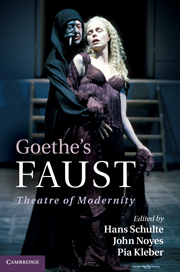Book contents
- Frontmatter
- Contents
- List of illustrations
- List of contributors
- Preface
- List of abbreviations
- Introduction
- PART I MODERNITY
- 1 Faust – today
- 2 Mephisto and the modernization of evil
- 3 Mephisto is the devil – or is he?
- 4 ‘Schwankende Gestalten’: virtuality in Goethe's Faust
- 5 Amnesia and anamnesis in Goethe's Faust
- 6 Magicians of modernity: Cagliostro and Saint-Simon in Goethe's Faust II
- 7 The blind Faust
- 8 From Faust to Harry Potter: discourses of the centaurs
- 9 Mistra and the Peloponnese in Goethe's Faust II
- 10 Goethe and the grotesque: the ‘Classical Walpurgis Night’
- 11 Re-defining classicism: antiquity in Faust II under the sign of the Medusa
- 12 Diabolical entrapment: Mephisto, the angels and the homoerotic in Goethe's Faust II
- PART II THEATRE
- Select bibliography
- Index
- References
10 - Goethe and the grotesque: the ‘Classical Walpurgis Night’
Published online by Cambridge University Press: 01 June 2011
- Frontmatter
- Contents
- List of illustrations
- List of contributors
- Preface
- List of abbreviations
- Introduction
- PART I MODERNITY
- 1 Faust – today
- 2 Mephisto and the modernization of evil
- 3 Mephisto is the devil – or is he?
- 4 ‘Schwankende Gestalten’: virtuality in Goethe's Faust
- 5 Amnesia and anamnesis in Goethe's Faust
- 6 Magicians of modernity: Cagliostro and Saint-Simon in Goethe's Faust II
- 7 The blind Faust
- 8 From Faust to Harry Potter: discourses of the centaurs
- 9 Mistra and the Peloponnese in Goethe's Faust II
- 10 Goethe and the grotesque: the ‘Classical Walpurgis Night’
- 11 Re-defining classicism: antiquity in Faust II under the sign of the Medusa
- 12 Diabolical entrapment: Mephisto, the angels and the homoerotic in Goethe's Faust II
- PART II THEATRE
- Select bibliography
- Index
- References
Summary
INTRODUCTION
In the past two decades a new direction has emerged in the interpretation of Faust ii. While earlier interpreters, like Wilhelm Emrich and Heinz Schlaffer, produced primarily complex symbolic and allegorical readings, the commentaries to the new editions of Faust ii by Albrecht Schöne and Ulrich Gaier illustrate how recent work has focused on material contexts, on media technology and on the performative character of the theatrical spectacle. Scholars have examined, for example, Goethe's inter-medial references to the iconography of the Renaissance masque and seriously considered the impact of modern media techniques like the panorama, the laterna magica and its development into the phantasmagoria. As a consequence of this new direction in interpretation, the ambiguous, deceptive character of certain scenes has gained more significance (FA 1:7.2, 466).
This new interpretive direction has, however, not yet been fully pursued with regards to the ‘Classical Walpurgis Night’ in Act 2, even though the scene begins with a thematization of the media of aesthetic presentation. Mephistopheles hopes to see ‘as if through ancient casements in the wild and dismal North, very horrid ghosts’ (7044–6) on the ancient battlefield. To his surprise, however, the medium is deceptive. He feels alienated (7081) by the masses of suspicious figures that surround him (7757). Yet these ‘throngs’ (7648) serve as a reflective medium for the actions of Faust, Mephistopheles and Homunculus. Indeed, in their double characteristic as amorphous and shaped, the masses present a poetical key for the whole spectacle.
- Type
- Chapter
- Information
- Goethe's FaustTheatre of Modernity, pp. 138 - 155Publisher: Cambridge University PressPrint publication year: 2011



